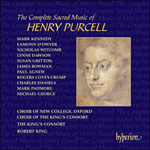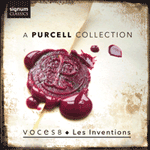This verse anthem dates most probably from 1689, by which time Purcell’s writing for the Chapel had all but come to an end. Indeed, it may be the only anthem that he wrote that year.
The Symphony is especially spacious, beginning with a series of four mysterious block chords before a winding series of imitative entries leads into a lyrical triple-time section of great beauty. Restraint is also shown at the first vocal entry, which is sung not by the full choral forces, but by the quintet of solo singers. The five-part texture allows harmonies of great richness, and ‘For kings shall be thy nursing fathers, and queens thy nursing mothers’ contains delicious suspensions. ‘As we have heard, so have we seen’ introduces the choir simply and gently, and it is only at the section ‘Be thou exalted, Lord’, constructed over a rising arpeggio, that the mood brightens, beginning with the five soloists, enlarging into the full choir, and ending in a series of Alleluias, each set more spacious than the previous ones. Finally the triple-time metre is replaced for the last stanza with seven bars of expansive duple-time Alleluias of great harmonic richness.
from notes by Robert King © 1991
L'hymne liturgique
Praise the Lord, O Jerusalem (‘Loue le Seigneur, Oh Jérusalem’) a probablement été écrit en 1689, époque à laquelle Purcell n'écrivait presque plus pour la Chapelle: c'est, en fait, peut-être le seul hymne qu'il écrivit cette année-là. La symphonie est particulièrement spacieuse, débutant par une série de quatre mystérieuses suites d'accords avant qu'une sinueuse série d'entrées imitatives ne mènent dans une section lyrique à trois temps de grande beauté. La première entrée vocale est aussi très mesurée. Elle n'est pas chantée par les forces chorales entières, mais par la quintette de chanteurs solistes. La texture en cinq parties permet des harmonies très riches, et dans `For Kings shall be thy nursing fathers, and queens thy nursing mothers' (‘Et rois et reines seront tes pères et mères nourriciers’) se trouvent de charmantes suspensions. ‘As we have heard, so have we seen’ (‘Comme nous l'avons entendu, nous l'avons vu’) introduit simplement et doucement le choeur, et ce n'est qu'à la section ‘Be thou exalted Lord’ (‘Soit loué, Seigneur’) qui est construit sur un arpège ascendant que l'atmosphère s'allège, d'abord avec les cinq solistes, puis s'élargissant jusqu'au choeur entier, et enfin dans une série d'alléluias, chacune plus étendue que les précédentes. Finalement, la mesure à trois temps est remplacée pour la dernière strophe par sept mesures d'expansifs alléluias binaires de grande richesse harmonique.
extrait des notes rédigées par Robert King © 1991
Français: Alain Midoux
Das Verse Anthem
Praise the Lord, O Jerusalem entstand aller Wahrscheinlichkeit nach 1689, als Purcell praktisch ganz aufgehört hatte, für die Chapel zu komponieren; möglicherweise ist es sogar das einzige Anthem, das er in diesem Jahr geschrieben hat. Die Sinfonia ist besonders umfangreich. Sie beginnt mit vier geheimnisumwitterten Akkordblöcken, ehe eine Folge imitativer Einsätze zu einem überaus schönen lyrischen Abschnitt im Dreiertakt überleitet. Zurückhaltung waltet auch beim ersten Einsatz der Gesangsstimmen, der nicht vom gesamten Chor, sondern von einem solistischen Sängerquintett getragen wird. Die fünfstimmige Struktur gestattet Harmonien von großer Üppigkeit, und ‘For kings shall be thy nursing fathers, and queens thy nursing mothers’ zeichnet sich durch reizvolle Vorhalte aus. ‘As we have heard, so have we seen’ führt den Chor auf einfache und behutsame Weise ein, und erst bei der Passage ‘Be thou exalted, Lord’, die auf einem ansteigenden Arpeggio aufbaut, hellt sich die Stimmung auf. Sie beginnt mit den fünf Solisten, weitet sich zum vollständigen Chor aus und endet mit einer Reihe von Allelujas, von denen jedes raumgreifender angelegt ist als die vorherigen. Zum Abschluß wird in der letzten Strophe der Dreiertakt durch sieben Takte gewaltiger, harmonisch reichhaltiger Allelujas im Zweiertakt ersetzt.
aus dem Begleittext von Robert King © 1991
Deutsch: Anne Steeb/Bernd Müller


 Purcell: The Complete Sacred Music
Purcell: The Complete Sacred Music Purcell: A Purcell collection
Purcell: A Purcell collection
